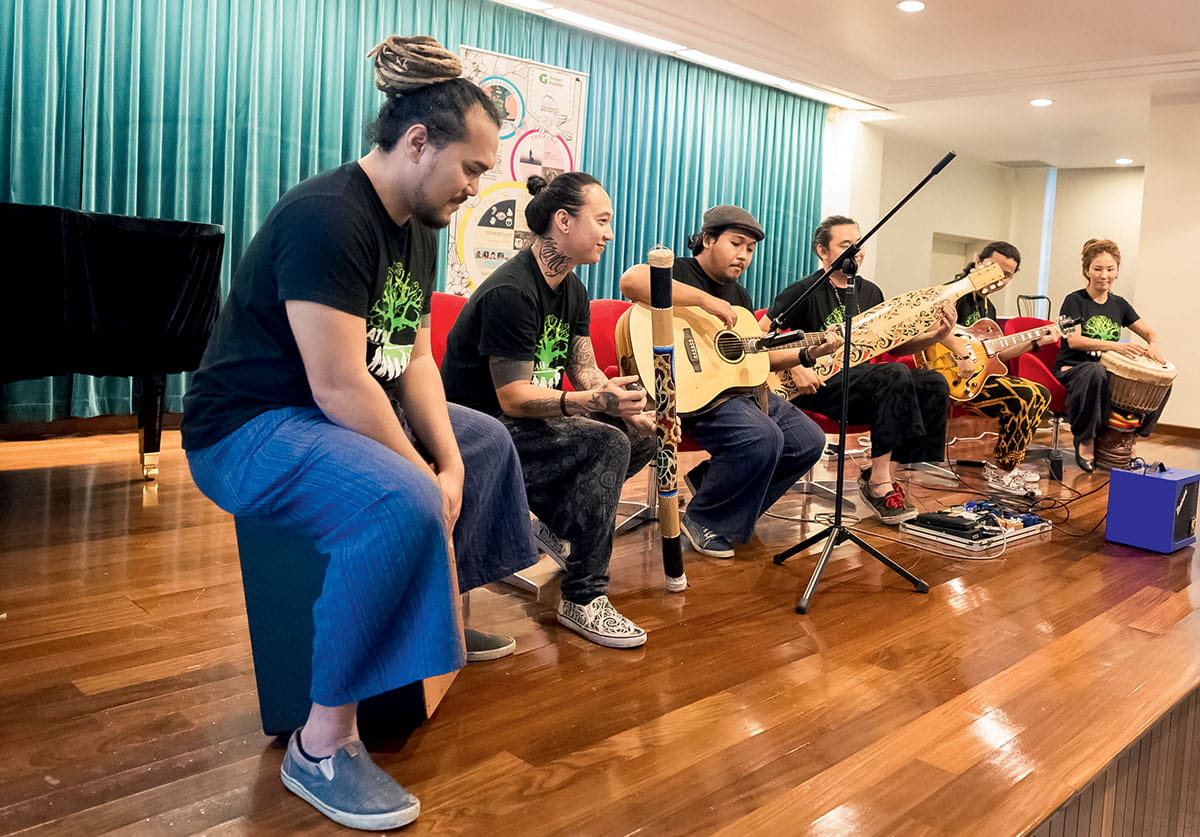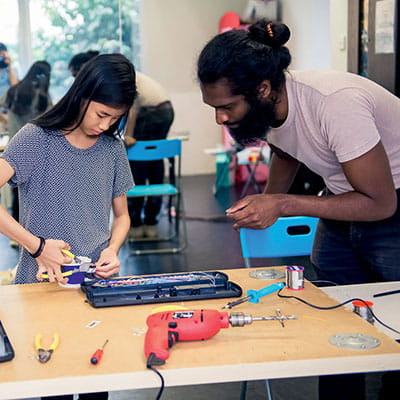Stories > The Art of Healing
The Art of Healing
Through art and cultural exchange platform CausewayEXchange, the Singapore International Foundation brought Singaporean and Malaysian communities together to explore the role of the arts in promoting healing.
BY PAMELA NG
PHOTOS SINGAPORE INTERNATIONAL FOUNDATION

At Adau, a Sarawak-based world music band, leading an interactive music session at Alexandra Hospital.
ingapore and Malaysia share deep historical, social and cultural ties. An annual art platform, called CausewayEXchange (CEX), seeks to deepen this connection through artistic and cultural exchange.
The two countries take turns to host CEX, which started in 2010. Last year, the Singapore International Foundation (SIF) collaborated with production company DMR Productions, non-profit arts organisation The Rice Company and non-profit creative enterprise Global Cultural Alliance for the 7th edition of CEX, which was held from Sept 1 to 13, 2016.
SIF added another dimension to CEX by introducing three Arts and Healing programmes, which explored how the arts can be used as a force for good, especially to help in healing. The programmes are part of SIF’s Arts for Good initiative, which promotes positive social change through collaborations between Singaporean and international artists, as well as through greater community involvement.
“Singapore and Malaysia share many cultural similarities that can help to inspire cross-cultural exchanges and foster greater ties between the two countries. Art is universal. Increasing collaborative efforts between artists will nurture trust and result in long-lasting relationships.”
Gurpreet Kaur Kalsi, Malaysian music therapist
The three programmes were titled Tales Of The Swordfish, Healing Through Arts and Doctors With A Cause. Tales Of The Swordfish involved a series of art workshops conducted by Kuala Lumpur-based theatre collective Main Wayang for students from Singapore arts training academy Little Arts Academy. It culminated in the staging of a multi-disciplinary public performance, based on a popular Singapore folklore about swordfishes.
Healing Through Arts, held at Singapore’s Alexandra Hospital, comprised an interactive music session led by Sarawak-based world music band At Adau, and Gurpreet Kaur Kalsi, a Malaysian music therapist. This was followed by a panel discussion by art and music therapists from Singapore and Malaysia on the therapeutic abilities of art and music.
The last programme, Doctors With A Cause, was also held at Alexandra Hospital. It featured a charity show in which Singaporean and Malaysian doctors employed their comedic and musical talents to raise funds for future Arts and Healing programmes under CEX.
CREATIVE THERAPY
 |
|
A collaborator (right) from Main Wayang, a Malaysian theatre group, teaching a Singaporean youth how to take an electronic musical instrument apart and use it to create new sounds. |
Shafiqa Nabeera, project manager for Main Wayang, said that it was interesting to learn about the different versions of the swordfish story. In Malaysia, the story is part of the Malay Annals and is often called Singapura Dilanggar Todak, which means Singapore is attacked by swordfishes. In Singapore, the story is associated with the origins of Bukit Merah and Tanjong Pagar, two districts in the country.
Said Shafiqa: “With our shared history and collective roots, cultural exchanges come naturally to Singaporeans and Malaysians. Despite our vast contemporary differences, we were built on the same foundations and share the same historical and cultural canon.” Nurhayati Haji Md Zan, 19, a Singaporean student who took part in the workshops, said: “It was empowering and helped us to understand how art can bridge differences.”
Aqram Mydin, an assistant manager for arts and community development at Singapore’s non-profit organisation The Rice Company, who was involved in staging the performance, agreed. “These crosscultural exchanges are a fantastic opportunity for participants to learn and understand each other better,” he said.
For the Healing Through Arts programme, elderly patients from Singapore-registered charity HCA Hospice Care were encouraged to express their feelings by thumping on drums.
Lama Majaj, a Singapore-based artist and registered art therapist, who is also the international operations manager at non-profit organisation The Red Pencil, was present at the event. She said that it was empowering to see patients creating music that can help contribute to their healing instead of being passive recipients of medical attention. She added: “I have always been inspired by how naturally the arts moves communities and builds resilience.”
Majaj also took part in a panel discussion and question-and-answer session following the music session. Joining her on the panel were Kalsi, Malaysian drama therapist Vanitha Chandrasegaram, and Dian Handayani, an art therapist from Singapore General Hospital’s Department of Psychiatry. Doctors, nurses and therapists also took part in the discussion.
The session left participants invigorated with ideas on how they could encourage the two countries to work together to use the arts as a healing tool. Handayani suggested that therapists from both countries organise a conference on creative arts therapy so that they can learn from each other or initiate a cross-cultural research project on the subject.
Doctors from Malaysia and Singapore rounded off the Healing Through Arts programme with their Doctors With A Cause performance. Dr Chang Tou Liang, Dr Thevi Thanigasalam and Dr Au Kah Kay played classical pieces on the piano. Malaysian Dr Jason Leong, who left the medical profession to become a full-time stand-up comedian, also entertained the audience with his quick wit and sharp observations on Singaporean and Malaysian cultures.
Summing up the experience of the participants, Kalsi said: “Singapore and Malaysia share many cultural similarities that can help to inspire crosscultural exchanges and foster greater ties between the two countries. Arts is universal. Increasing collaborative efforts between artists will nurture trust and result in long-lasting relationships.”
